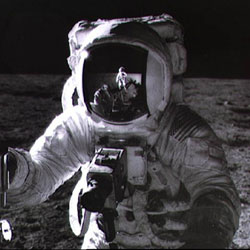
Pete Conrad’s self portrait. Image credit: NASA. Click to enlarge.
Picture this: An astronaut, on the Moon, hunched down over a rock, hammer in hand, prospecting. Suddenly, over his shoulder, there’s a flash of light on the sun.
The radio crackles: “Explorer 1, come in. This is mission control.”
Explorer 1: “What’s up?”
Mission Control: “There’s been a solar flare, a big one. You need to take cover. The radiation storm could begin in as little as 10 minutes.”
Explorer 1: “Roger. I’m heading for the Moon Buggy now. Any suggestions?”
Mission control: “Yes. Make sure you protect your hips.”
Protect your hips?
That’s right. Protecting the hips may be a key to surviving solar storms. Other sensitive areas are the shoulders, spine, thighs, sternum and skull.
Why this odd list of body parts? The bones in these areas contain marrow — the “blood factory” of the body. Delicate bone marrow cells are especially vulnerable to solar storms; a major dose of solar protons coursing through the body could wipe them out. And without these blood-forming marrow cells churning out a steady stream of new blood cells, a person would run out of blood in as little as a week. A bone marrow transplant would be required–stat!–but they don’t do those on the Moon.
So to survive a solar radiation storm, your first priority must be to protect your bone marrow.
With NASA sending people back to the Moon by 2018, the issue of surviving solar radiation storms is more important than ever. Outside the protection of Earth’s magnetic field and with virtually no atmosphere overhead, an astronaut walking on the lunar surface is exposed to the full brunt of solar storms.
The best solution is to take cover, to get back to a radiation shelter. But if shelter is too far away to reach in time, wearing a spacesuit with extra radiation shielding over these key marrow-rich areas — shoulders, hips, spine, etc. — could mean the difference between living and dying.
“Bulking up the entire spacesuit with extra shielding might not be practical,” says Frank Cucinotta, NASA’s Chief Scientist at the Johnson Space Center, “because then the spacesuit would be too cumbersome.” Astronauts have to be able to walk, hop, bend over, reach for objects and tools. Too much shielding would make these simple moves impossible–hence the idea of selective shielding:
A layer of a plastic-like material called polyethylene only 1 cm thick could prevent acute radiation sickness. “For all but the worst flares, this would be enough to keep the astronaut’s blood system intact,” Cucinotta says. If as few as 5% of those marrow cells survive, the bone marrow will be able to regenerate itself, and the person will survive, no transplant required.
An astronaut, so shielded, might still develop long-term health problems: cancer, cataracts and other maladies. “No spacesuit can stop all solar protons,” explains Cucinotta. But if the blood supply survives, the astronaut will too, long enough to worry about the long term.
At the moment, this idea of designing a spacesuit to selectively shield the astronaut’s bone marrow is just that: an idea. Cucinotta says that many strategies are being considered for protecting the astronauts on the Moon. But the response to the idea of selective shielding has been positive, Cucinotta says. It might work.
If the idea catches on, post-Apollo spacesuits would look a little different, with beefy shoulders, wide hips, and bulbous helmets, among other things. Fashions change, sometimes for the better.
Original Source: Science@NASA Article
